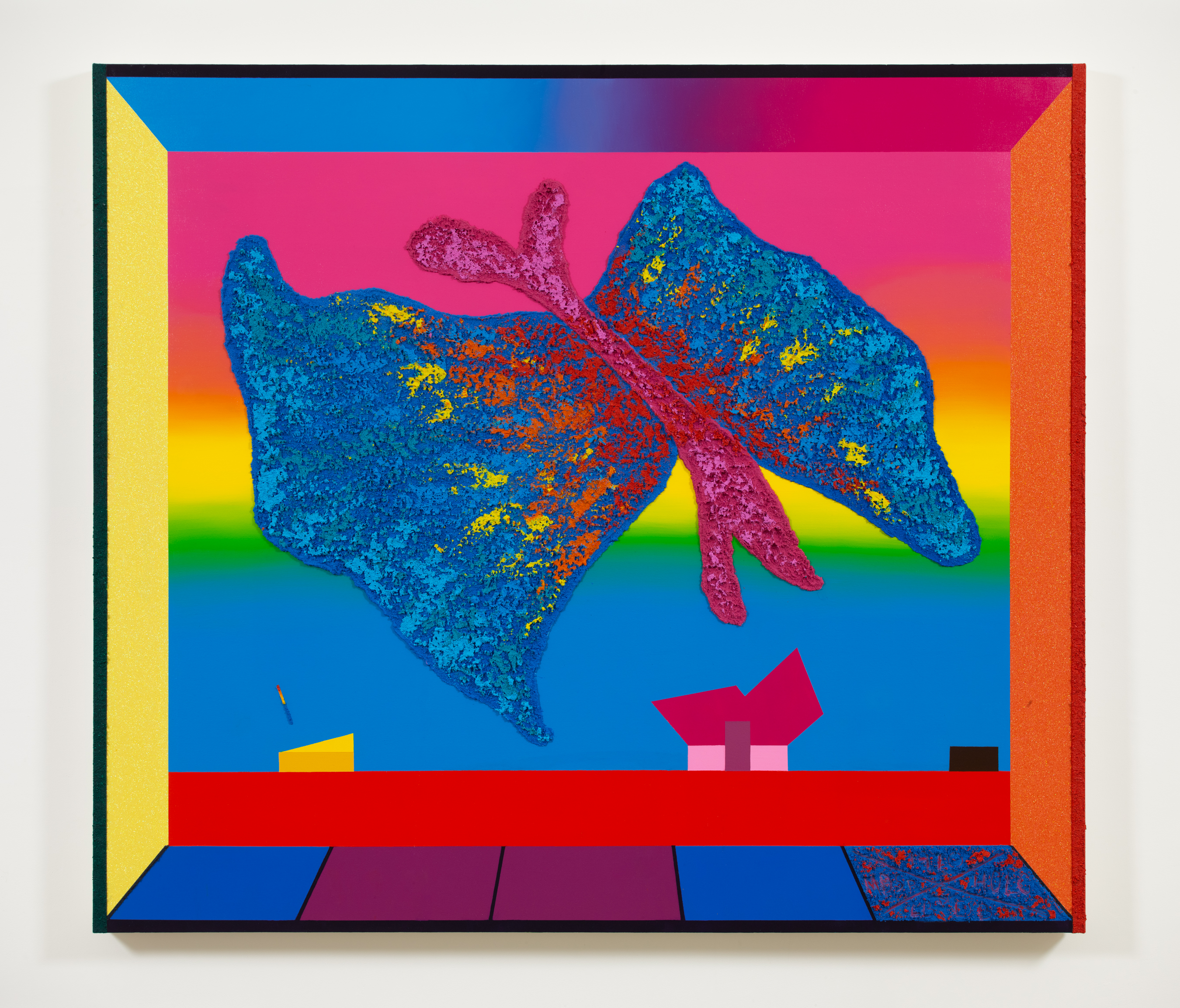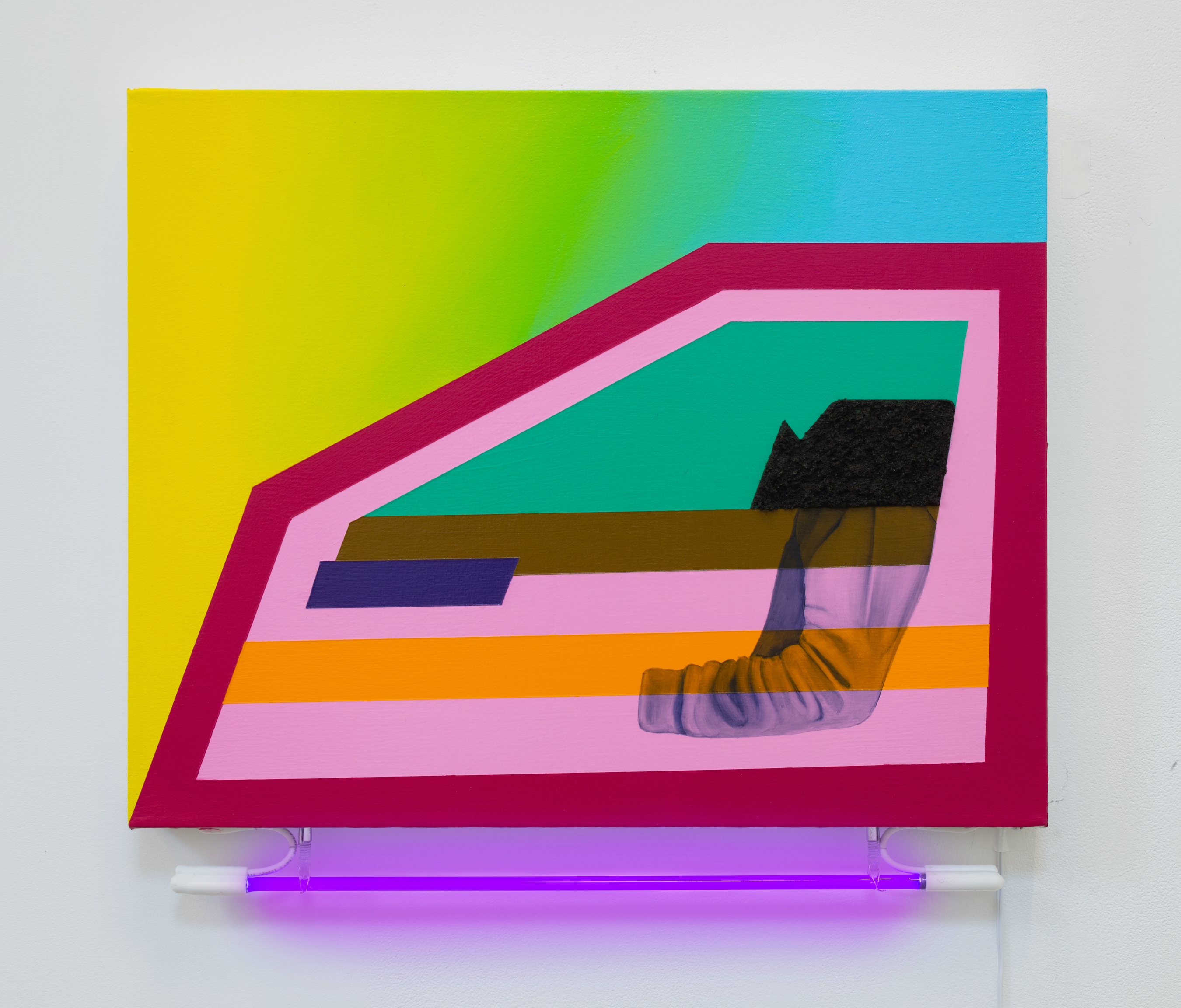Jamaal Peterman
White Roads on Black Soil
December 10, 2021—January 15, 2022
Jamaal Peterman’s complex, cryptographic work reproduces the world as a kind of simulation that is accessed through the portal of each painting. Following from the artist’s exhibition last year—which spoke to invisible micro and macro systems of corporate finance, surveillance capitalism, and their interlocking weapons of destruction—Peterman’s new body of work moves in closer to the body as it travels through place and time, and as the artist reflects on his own movement through life.
Peterman was raised in South Florida before moving to Maryland, and later to New York, where he currently lives. White Roads on Black Soil hones in on each location, intervening and extrapolating upon the nature of how these city spaces are made and dismantled, by activating their own inherent abstractions. In Walking through another experiment, the Marcy public housing complex in Brooklyn, New York appears in aerial perspective, now resembling 8-Bit beings ready to turn and move. Another aerial view, here of Baltimore’s hypersegregated Butterfly zones, forms the scattered pink and blue composition at the center of Black Flight. With 95 South, Peterman traces interwoven lengths of highway whose presence demolished African American housing in South Florida under the Federal Aid Highway Act of 1956.
In another pair of works, Peterman speaks to the implementation of residential division by laying down train tracks, which appear through the simplified schematic of two parallel lines that hold apart two parallel sets of homes. With a trio of interrelated paintings, Peterman places the figure inside of a car, connecting to both the broader structures in question and, more personally, to how the artist himself moves through space each day—with the window down. Across Peterman’s works, textured surfaces using sand and glitter further ricochet the artist’s references, adding another layer of material interpretation. Cement-like areas that divide and frame each composition echo the disruption and isolation rendered by the various forms of demolition that Peterman references. The visual contrast and vibration of these areas double as reflections of the intense air and sound pollution that remain as actively destructive forces long after these structures themselves were put into place. While we use these highways every day and reside within these structures, we cannot forget how they have impacted black culture in the past and present, across school systems, health, family wealth, and daily policing—despite the fortitude of community that carries us through. As Peterman summarizes: “This is my journey on a road that American culture helps destroy and rebuild.”
The exhibition takes its title from a poster that emerged during the Washington DC freeway revolts, part of larger country-wide revolts that began in 1956 and continued into the late ‘60s and early ‘70s. One of the anti-freeway citizen group Emergency Committee on the Transportation Crisis (ECTC)’s rallying slogans was “White Man’s Road Through Black Black Man’s Home,” which is a variation on a statement made by ECTC leader Sammie Abbott during his 1967 testimony in Washington DC. Abbott’s partner at ECTC, Reginald Booker, picked up on the remark, turning it into a galvanizing slogan of black opposition to the freeways. Abbott, who was also a graphic artist, created dozens of posters featuring it, while the phrase was also appropriated across others cities where freeways were being routed through African American and other minority communities.
Jamaal Peterman (b. 1990, Fort Lauderdale, FL; lives and works in Brooklyn, NY) received his MFA at Pratt Institute (2019) and BFA from the University of Maryland Eastern Shore (2014). He has been included in exhibitions at the Museum of Contemporary African Diasporan Art (MoCADA), Public Art Fund, New York; the University of Chicago; Kavi Gupta, Chicago; and James Fuentes, New York. Peterman has undertaken residencies at MASS MoCA, Wassaic Project Residency, and Fountainhead Residency. White Roads on Black Soil follows Peterman’s first exhibition at the gallery, Grunch In Bed, and his online exhibition, Tales from the Hood, both held in 2020.
Press Release
Download PDF (56.35 KB)
Black Flight, 2021
Signed and dated verso
Oil, vinyl glitter, sand on canvas
70 x 80 inches

Walking through another experiment, 2021
Signed and dated verso
Oil, vinyl glitter, and sand on canvas
65 x 96 1/8 inches

95 South, 2021
Signed and dated verso
Oil, vinyl glitter, and sand on canvas
70 x 80 inches

Walk Tall, 2021
Signed and dated verso
Oil, vinyl glitter, and sand on canvas
60 x 48 inches

Train Up, 2021
Signed and dated verso
Oil, vinyl glitter, and sand on canvas
60 x 48 1/4 inches

Black Male, Dark blue car, Blue light, 2021
Signed and dated verso
Oil and sand on canvas with neon light
26 1/2 x 30 x 2 1/2 inches

Black Male, Orange car, Red lights, 2021
Signed and dated verso
Oil and sand on canvas with neon light
26 1/2 x 30 x 2 1/2 inches

Black Male, Red car, Purple light, 2021
Signed and dated verso
Oil and sand on canvas with neon light
26 1/2 x 30 x 1/2 inches

Installation view, White Roads on Black Soil, James Fuentes, New York, 2022

Installation view, White Roads on Black Soil, James Fuentes, New York, 2022

Installation view, White Roads on Black Soil, James Fuentes, New York, 2022